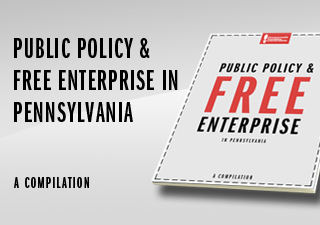Commentary

Public Policy and Free Enterprise in Pennsylvania
PREFACE
Nathan Benefield
Public Policy and Free Enterprise in Pennsylvania represents a partnership with the Commonwealth Foundation and the department of economics at Duquesne University. The papers were prepared by advanced-level undergraduate and graduate economics students alongside Dr. Antony Davies, an associate professor at Duquesne and a member of the Commonwealth Foundation’s Council of Scholars. This project represents the beginning of an increased effort to connect scholars in the academic world with current public policy issues facing the Keystone State.
The topics examined include five of the key public policy issues and economic trends facing Pennsylvania.
In “The Cost of Labor Unions in Pennsylvania,” Laura Vicinie and Dr. Davies find:
- Over the past sixty years, increases in union membership rates correlate with slower growth in real per-capita income growth slows, a decline in real imports, and no significant change in unemployment rates or real exports.
- These results suggest that increased union membership has no positive effect on the economy. While some of the results are not statistically significant, they all point in a direction that suggests increased union membership has a negative effect on the economy.
- The reality of unions changed from protecting workers against employers’ monopsony power in the past to protecting union workers against non-union workers.
In “Public Teacher Compensation,” Jonathon Scott and Dr. Davies find:
- The cost to taxpayers of a newly hired teacher—from age 22 through age 80 starting at the baseline salary of $40,800—will be $13 million. Of this total, $6 million is the teacher’s future salary, $1 million is the teacher’s future health care benefits, and $6 million is the teacher’s future pension benefits.
- The average salary for public school teachers varies significantly across regions. Schools in the Allegheny Mountains area have the lowest-paid teachers at an average salary of $49,819, while teachers in the Philadelphia area earn 25% more, or $62,568 on average.
- The strongest predictors of teacher salaries are geographic area, years of service, and education.
In “Medical Malpractice Reform in Pennsylvania,” Kait Wolf and Dr. Davies find:
- Legal reforms designed to limit medical professionals’ liabilities result in lower medical malpractice premiums and will attract more medical professionals to Pennsylvania.
- Over the past five years, there have been over 1,000 medical malpractice suits settled or awarded in Pennsylvania. At an average award of $330,000 (in 2009 dollars), those cases represent a combined cost to medical malpractice insurers of over $375 million. Non-economic damage reform would have reduced this amount by almost $150 million.
- The average settlement and award in states and years with joint and several liability reforms is $275,000 versus more than $350,000 for states and years with no reform.
- States with punitive damages rules exhibit an average settlement and award amount of $278,000. States without punitive damage rules exhibit an average settlement and award of $320,000, or 15% higher.
In “Gaming and Socioeconomic Indicators: Evidence from the States,” Lauren Mondschein and Dr. Davies find:
- State and local tax revenue per capita is higher among gaming states than among non-gaming states, but that there is no significant difference in state and local tax revenues among the categories of gaming states.
- Gaming revenue adds significantly to tax revenues for states that allow private gaming, but not for states that have state-sponsored gaming only.
- The data between gaming and unemployment rates is ambiguous, but per-capita income is significantly higher in gaming states than in non-gaming states.
- The incidence of violent crime is lowest among states with state lotteries only, and higher among states with no gaming and with private gaming.
In “The Effects of Trade in Pennsylvania,” Devin Bowen and Dr. Davies find:
- In Pennsylvania, employment is higher during times of greater trade. Average incomes are also higher during periods of greater trade.
- Opening markets to free trade costs the state jobs in less competitive industries, but adds jobs in our more competitive industries. In sum, trade shifts Pennsylvania’s job base from unhealthy to healthy industries, leaving the commonwealth with more jobs, better-paying jobs, and an economic base built on more industries that are better able to survive into the future.
These five papers offer unique and important insights for Pennsylvania policymakers and advocates on the fiscal and economic effects of key policy areas. Dr. Davies and his students have answered some critical questions about the benefits of international trade, the impact of legalized gambling, the potential savings from medical malpractice reform, the costs of public school teachers, and the economic impact of union membership for Pennsylvania residents.